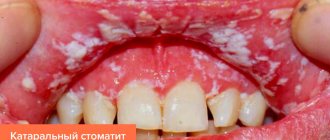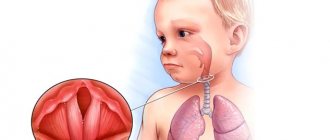Herpetic stomatitis (or herpes stomatitis ) is one of the types of stomatitis, damage to the oral mucosa. Typically, acute herpetic stomatitis (primary) and recurrent herpetic stomatitis (other names are sometimes used for it - chronic herpetic stomatitis or chronic recurrent herpetic stomatitis ).
Herpetic stomatitis can be classified by phase (catarrhal stomatitis, ulcerative or aphthous stomatitis) or by severity (mild, moderate, severe).
Features of the disease in adults and children
Herpetic stomatitis occurs frequently in children. Children aged 1 to 3 years are especially susceptible to this infectious disease. The reason that the disease is typical only for children lies in the characteristics of children of this age and their fragile immune system.
After a year, breastfeeding usually stops, and therefore the mother’s antibodies stop entering the child’s body. The immune system is under strain from viruses, infections and bacteria, which quickly attack the child upon contact with other children, adults, and exploring the world around him.
Irregular hand hygiene, being in a closed room with carriers of the infection in an open viral form leads to the fact that particles of the herpes virus enter the body of a young patient. The inflammatory process usually occurs in the oral cavity. This is how the disease appears.
Herpetic stomatitis in adults can also manifest itself. However, the immune system of an adult is more developed and stronger. Therefore, the disease usually occurs in a mild form. If in childhood the patient easily suffered from a disease that did not have time to develop into a recurrent form, the disease is unlikely to manifest itself again with frequent frequency. But at an advanced stage, stomatitis will most likely manifest itself again, but not necessarily in a severe form.
According to statistics, approximately 1 in 8 children under the age of three has suffered from herpetic stomatitis at least once. An adult gets it extremely rarely - during periods of recovery from a more serious illness, which has significantly weakened his immunity. The disease manifests itself in no more than 3% of the population, who in childhood experienced the consequences of recurrent oral stomatitis.
Questions:
Is it possible to quickly cure stomatitis?
On average, stomatitis is treated from 5 to 10 days, but in complex forms of the disease it can last up to 3 weeks. You can reduce pain and eliminate other symptoms more quickly with the help of topical products (rinses, mouth ointments). It should be remembered that even if the pain and rashes decrease, treatment must be completed completely to eliminate the infection.
Is it possible to cure stomatitis at home?
In most cases, stomatitis can be successfully treated at home, but to find the right treatment, you need to consult a specialist. The disease can be caused by a bacterial, viral or fungal infection. To determine this, it is necessary to carry out diagnostics. Having made an accurate diagnosis, the doctor prescribes medications for internal use and local use (rinses, ointments, etc.).
Accompanying services:
Dentist consultation
Sources:
Herpetic stomatitis: symptoms
When a person has acute stomatitis, its manifestations are difficult to miss. Signs of the disease usually appear on the sixth day after infection. But sometimes the rest period can last up to 25 days after infection with the herpes virus.
The symptoms of the disease are as follows:
- High temperature in the first 2 days after detection of the disease. When the rest period ends, the patient experiences a febrile rise in temperature. In the mild stage, up to 38 degrees, lasts no more than 48 hours. In the middle stage, the temperature is 1-1.5 degrees higher and drops on the second day. In the severe stage, there may be an increase in body temperature up to 40 degrees. It can last more than two days.
- Change in color of the mucous membrane in the oral cavity. The shade becomes brighter, to a deep red color.
- Pain when eating. When everything inside the mouth becomes inflamed, chewing becomes unbearable. A person loses his appetite and his mood worsens.
- The appearance of inflammation on the oral mucosa. When the inside of the mouth is covered with small ulcers of a white, light pink hue, which can fester and bleed - this is the main symptom of herpetic stomatitis.
- Ulcers increase in number. They may appear and grow over the next three days. The second name for ulcers is aphthae.
When the disease subsides, the aphthae gradually heals. A person gains an appetite, and painful sensations in the process of chewing food disappear. The clinical picture of recovery in dentistry is observed with the complete disappearance of any formations from the oral cavity.
Weak immunity is the main reason why acute herpetic stomatitis reappears. In adults, it usually occurs in a mild form, often without fever and with minor aphthae in the oral cavity. In preschool children, the oral cavity becomes more inflamed. But it rarely goes into a strong stage with relapses.
Treatment
Herpetic stomatitis requires not only local treatment, but also general treatment. It is necessary to regularly treat the oral cavity with antiseptic, disinfectant and wound-healing preparations. Frequent rinsing with herbal decoctions will help quickly calm the inflammatory process. In some cases, acute herpetic stomatitis may require not only treatment with antiviral drugs, but also with local antibiotics to prevent the development of a bacterial infection in areas of severe tissue damage.
Any doctor will probably recommend that you isolate a patient with an acute infection so as not to infect others. In addition to individual dishes, personal hygiene items and linen, it is necessary to provide the patient with a constant flow of fresh air, plenty of fluids and protection from direct sunlight (most patients experience increased photosensitivity during illness).
Adults can be treated with drugs such as florenal, bonaftone, tebrofen ointments; a child is better treated with interferon and oxolinic. To quickly heal the wound surface, it is necessary to treat erosions and ulcers with sea buckthorn, flax, rose hip, peach oils, Kalanchoe or aloe juice. In addition, in cases of herpes stomatitis, treatment most often includes antihistamines to prevent an allergic reaction, especially in children. In some cases, it is possible to use antipyretic drugs, but in any case, consultation with a specialist is necessary.
In more severe cases of acute stomatitis, treatment can be supplemented by taking immunomodulatory and vitamin preparations to increase the level of body resistance. In some cases, hospitalization and intravenous administration of drugs are indicated, especially for the treatment of young children.
To combat the chronic form of the disease, the doctor may recommend an antiherpetic vaccine, however, keep in mind that during periods of exacerbation it is very dangerous to take any vaccinations, and the validity of such a vaccine is not unlimited.
Principles of treatment of herpetic stomatitis in dentistry
It is easier to stop herpetic stomatitis at the initial stage, when the disease has not yet spread to the entire oral cavity. In the presence of high temperatures, the process of getting rid of a viral infection is complicated, and the patient may be prescribed treatment in a hospital.
Main directions in therapy:
- Taking immune-strengthening drugs. The disease affects those with weak immunity. Taking medications that will help strengthen the immune system will strengthen the body's resistance.
- Taking antiviral drugs. Treatment of stomatitis is carried out only under the supervision of a doctor. Any dental clinic has a practice of getting rid of this disease.
- Fighting infection in the oral cavity. Rinsing with antiseptic solutions helps eliminate the visible consequences of the disease that appear during the progression of the acute stage.
You should not self-medicate. All medications should only be prescribed by a doctor. In dentistry, the main focus is on restoring the normal state of the oral cavity. If the disease manifests itself in the form of aphthae on other parts of the body, for example, fingers, you also need to consult a virologist or dermatologist.
Stomatitis caused by fungi
Candidal stomatitis is a fungal disease caused by fungi of the genus Candida.10 Young children and the elderly are more often affected; people with diabetes and xerostomia (dry mouth), pregnant women and people with weakened immune systems are also at risk. Elderly people wearing removable dentures often get sick.
The main symptom of fungal stomatitis is a burning sensation and the presence of a white, cheesy coating, when removed, a swollen, red mucous membrane appears. The general condition of adults with candidal stomatitis is practically not affected.
Prevention of herpetic stomatitis
Treatment of herpetic stomatitis can take several weeks. Therefore, it is easier to monitor hand and oral hygiene than to later deal with the consequences of a viral disease.
In children under 5 years of age, herpetic stomatitis appears mainly due to contact with other carriers of the disease or poor hygiene. Particular danger should be exercised when walking in the sandbox or on popular children's slides. There are pockets of microbes concentrated there, and children at this age do not always control their hands when they touch the mucous membrane.
For prevention, you should wash your hands after each contact with sand or visiting public places, including shops, clinics, banks. If someone you know has herpes, close contact and handshakes should be avoided.
Reasons for the development of stomatitis
There are several main reasons for the development of stomatitis: viral, bacterial and fungal infections, allergies, burns or other damage to the mucous membrane. At the same time, for the disease to begin to develop, predisposing factors are needed. Normally, the microflora of the oral cavity and constant salivation protect the mucous membranes from the development of infection. If pathogenic microorganisms get on it, and the immune defense is weakened, they begin to actively multiply, which leads to the development of stomatitis.
Factors that increase the risk of developing stomatitis:
Associate Professor E. A. Karmalkova
Belarusian State Medical University
Human herpetic infection is currently one of the most common and uncontrolled.
Up to 95% of the world's population is infected with the herpes simplex virus. The virus is capable of infecting almost all human organs and systems, causing various clinical forms of infection (diseases of the central and peripheral nervous system, liver and other parenchymal organs, eyes, skin, mucous membrane of the gastrointestinal tract, genitals, mouth), as well as has a certain significance in intrauterine pathology of the fetus. A combination of various clinical forms of herpetic infection is often observed. Pathology of herpetic nature plays a leading role among diseases of the oral mucosa in children. The most commonly diagnosed is acute herpetic stomatitis (AHS), which accounts for 85% of all diseases of the oral mucosa in children and ranks first among all lesions of the oral mucosa. Children of various age groups, including newborns, suffer from AHS. Herpetic infection of newborns can be a consequence of infection in the womb (5% of newborns), in the birth canal and after birth (80%), from maternity ward staff (15%). In premature infants, herpetic infection occurs more often than in newborns born at term, and amounts to 11:100, respectively. AHS is most common in children aged 6 months to 3 years. This is explained by the fact that at this age the antibodies received from the mother through the placenta disappear in children. In addition, the morphological features of the structure of the oral mucosa are important. The manifestation of herpetic infection in the form of AHS in children is also associated with frequent natural violations of the integrity of the oral mucosa as a result of teething. Pathological effects in viral diseases are the combined result of the direct effects of viruses on the host body and tissue damage during the immune response. Infection with the herpes simplex virus occurs when the virus is transmitted with biological media in various ways: airborne, contact, transplacental, blood transfusion, sexual. In all cases, viral infection begins with the adsorption of viral particles and penetration of the virus into the cell. The herpes simplex virus is DNA-containing and belongs to the neurotropic group. Its pathological effect on the body during AHS manifests itself in the form of symptoms of intoxication of the nervous system: lethargy, drowsiness or increased excitability. Characterized by restless behavior, irritability, nausea, vomiting, increased body temperature, decreased or loss of appetite, headache, pain in muscles, eyeballs, large joints, adynamia, etc. If the body’s defenses cannot cope with the pathogen, then During the incubation period, primary viremia is observed, that is, the virus enters the bloodstream. The virus disseminates to all organs and tissues through the bloodstream, and certain portions of the virus are excreted in the urine. Settling in the liver, spleen, and other organs and tissues, the virus multiplies quickly. Tissue damage occurs in the form of foci of necrosis. After intensive reproduction in these organs, the virus is released into the blood in high concentrations (with generalized herpes, the concentration of the virus can reach 106 infectious units per 1 ml of blood). This condition is called secondary viremia. It is observed in the prodromal period and in the first days of the disease. During secondary viremia, viruses rush to the skin and mucous membranes, where their intracellular reproduction continues. With a herpetic infection, the symptom of bleeding of the mucous membrane of the mouth, gums, and sometimes the nose is clearly expressed. Pathological changes in homeostasis can lead to intravascular thrombus formation. It is assumed that necrotic areas in organs and tissues during herpetic infection arise as a result of both direct cell destruction by the virus and as a result of capillary thrombus formation. The herpes simplex virus is capable of causing a state of immunosuppression in the body, which manifests itself in changes in natural immunity during various periods of the disease in children with stomatitis. Clinical manifestations During the course of the disease, as with every infectious disease, five periods are distinguished: incubation, prodromal, development/height of the disease, extinction and clinical recovery. The incubation period of OGS lasts from 2 to 26 days (on average 6–12). The severity of OGS is assessed based on a set of symptoms of a general (degree of intoxication) and local (severity of lesions of the oral mucosa) nature. Depending on the severity and duration of changes in the general condition and mucous membrane of the oral cavity, mild, moderate and severe forms of OGS are distinguished. The severe form of AHS occurs much less frequently than the mild and moderate forms, as it is caused by a pronounced immunodeficiency of the child’s body. The incubation period is not clinically evident. The prodromal period begins with a rise in body temperature to 37–40 °C. Already in the prodromal period, the child’s general condition worsens: weakness, moodiness, loss of appetite appear, and possible catarrhal tonsillitis and ARVI symptoms. In a number of cases, inflammation of the mucous membrane of the nasal cavity and upper respiratory tract is found to be of varying severity. In case of a severe course of the disease in the prodromal period, the child has all the signs of an incipient acute infectious disease: adynamia, headache, musculocutaneous hyperesthesia, arthralgia, etc. Symptoms of damage to the cardiovascular system are common: brady- or tachycardia, muffled heart sounds, arterial hypotension . Some children experience nosebleeds, nausea, vomiting, and pronounced lymphadenitis of not only the submandibular, but also the cervical lymph nodes. In the oral cavity, hyperemia and swelling occur in the area of the gingival edge of the front teeth (localized catarrhal gingivitis) or in the area of all teeth (generalized catarrhal gingivitis). Hyperemia intensifies, bleeding gums appear. The rash is preceded by regional lymphadenitis. In most cases, after 1–2 days, against the background of increasing hyperemia, single or grouped lesions appear in the oral cavity, the number of which can vary from 5 to 100. Rashes can be single or multiple. The child does not eat, sleeps poorly, and symptoms of intoxication increase. When examining the oral cavity, you can see elements of the lesion that are at different stages of clinical and morphological development: plaques, erosions, aphthae, spots (false polymorphism). Under unfavorable conditions, erosions merge with the formation of extensive zones of necrosis, and ulcerative necrotizing gingivitis develops. During this period, salivation increases, saliva becomes viscous and viscous. There is an increase in ESR up to 20 mm/h, leukopenia, and sometimes slight leukocytosis. The level of band neutrophils and monocytes is usually within the upper limits of normal, lymphocytosis and plasmacytosis are detected. In severe cases of the disease, rashes in the oral cavity recur many times, merge, forming large areas of necrosis of the mucous membrane. Not only the lips, cheeks, tongue, soft and hard palate are affected, but also the gingival margin. Rashes in the form of grouped herpetic blisters appear on the skin of the perioral area, eyelids, and earlobes; Paronychia develops on the fingers. Catarrhal gingivitis turns into ulcerative-necrotic. There is a putrid odor from the mouth, profuse salivation mixed with blood. There are streaks of blood in the secretions from the nose and larynx, and severe nosebleeds are sometimes observed. In the blood of children with a severe form of AHS, leukopenia with a shift of the leukocyte form to the left, eosinophilia, single plasma cells, and young forms of neutrophils are detected (toxic granularity is detected). After a few days, the elements of the rash acquire a “marbled” color, the edges and center are blurred, a halo of hyperemia appears around and they take on the appearance of ordinary aphthae. The elements of the lesion are already less painful. The duration of the period of extinction of the disease depends on the degree of resistance of the child’s body, the presence of carious teeth, and rational therapy. Epithelization of the lesion elements takes up to several days. After epithelialization of the elements, the phenomena of catarrhal gingivitis persist, especially in the area of the anterior teeth of the upper and lower jaws. Lymphadenitis of the submandibular lymph nodes during the recovery period persists for 7–10 days. In children with a mild form of the disease, as a rule, there are no changes in the blood; sometimes only towards the end of the disease does slight lymphocytosis appear. Natural immunity in a mild form suffers slightly, and during the period of clinical recovery, the child’s body’s defenses are at the level of those in healthy children, that is, in a mild form of AGS, clinical recovery means the complete restoration of the impaired defenses of the body. The period of extinction in moderate and severe forms lasts a long time, depending on the duration of the previous period of rash, the state of the child’s somatic health, the level of oral hygiene, the timeliness and correctness of treatment. Humoral factors of the body's natural immunity during the height of the disease in moderate and severe forms of AGS are sharply suppressed, their activity is not restored several weeks after clinical recovery. Treatment should have etiotropic, pathogenetic, symptomatic directions. Since we are talking about a systemic infection with manifestations in the oral cavity, both general and local (for the oral cavity) agents and treatment methods are used in the treatment of OGS. It is necessary to take into account the individual characteristics of the child, the stage of development of the disease and the presence of symptoms of concomitant pathology. Objectives of general treatment: stopping the reproduction of the herpes simplex virus in the tissues and environments of the body (complete liberation of the body from the virus is currently not possible); reduction of symptoms of intoxication; normalization of metabolic processes. In case of moderate and especially severe disease, it is advisable to carry out general treatment together with a pediatrician. Objectives of local treatment: eliminate or reduce painful symptoms in the oral cavity; prevent recurrence of lesions; influence pathogenic associative microflora; accelerate the epithelization of lesion elements. Treatment tactics In all cases, during the period of illness, the child is isolated and exempted from visiting the children's group. In the complex of therapeutic measures, an important place is occupied by rational nutrition and proper organization of child care. Food should be complete, high-calorie (mainly liquid or semi-liquid) and not irritate the inflamed mucous membrane of the oral cavity. Before feeding, it is necessary to numb the mucous membrane. Great care must be taken to ensure adequate fluid intake. Mild form (treatment is predominantly local) During the peak stage, the oral cavity is treated with antiseptic drugs and antiviral ointments 3-4 times a day, an hour after meals. To reduce the pain of the lesions, local anesthetics can be used. In the stage of extinction of the disease, low-intensity laser radiation (helium-neon laser) is prescribed. Local treatment is carried out in the same mode as in the peak stage, but antiviral drugs are replaced with agents that promote epithelialization. To reduce gum bleeding, applications of astringents are used. Moderate and severe forms require complex treatment. In the stages of the height and decline of the disease, treatment is carried out using the same methods and drugs as in the mild form, but requires more time. Treatment of severe forms of AHS is often carried out in a hospital setting to create adequate conditions for replacing tablet forms of antiviral drugs with injectable ones, organizing detoxification and rehydration therapy and parenteral nutrition. Prevention of herpes simplex virus stomatitis It is necessary to take care of organizing some measures to prevent the spread of the herpes simplex virus, which are important for protecting the health of young children who do not have the proper level of immunity. To prevent pre- and intrapartum infection, a pregnant woman suffering from chronic recurrent herpetic stomatitis and her obstetrician should pay attention to the danger of viremia and transmission of the virus to the child. They are considering the issue of suppressive treatment of a herpetic infection in a pregnant woman, and in the case of genital herpes, delivery by cesarean section. To prevent infection of children from family members and employees of medical and children's institutions with recurrent herpes infections, it is necessary to organize: adequate antiherpetic treatment of carriers of the herpes simplex virus; strict sanitary control of their behavior during the period of relapse: the use of masks, only personal hygiene products and utensils, control of hand cleanliness, a ban on kissing, sampling the child’s food, etc.; preventive antiherpetic treatment of weakened children. To prevent the spread of infection in children's groups, medical personnel of a child care institution should be motivated to organize preventive and anti-epidemic work in groups both when outbreaks occur and during their absence, namely: regularly ventilate, disinfect (including quartz) premises, wash toys; Conduct daily examinations of children in order to identify patients with AHS or chronic recurrent herpetic stomatitis; take measures to isolate sick children; Children who have been in contact with sick people should receive antiviral prophylaxis for 5 days. Conducting an examination of temporary disability According to the instructions, a temporary disability certificate can be issued to parents for caring for a sick child for a maximum of 14 days. The attending physician issues a sick leave for 6 days, after which the decision is made by the VKK. Medical examination of children. The frequency of follow-up depends on the severity of the disease. stomatitis
Questions and answers
How to treat stomatitis at home?
Prescribing medications for stomatitis is possible only after examination by a specialist and establishing the causes of the disease. All types of stomatitis are treated at home according to the prescribed course of medications for internal use and local healing agents. The patient is admitted to the hospital only in an emergency, if the examination reveals a serious pathology of the internal organs.
Is stomatitis contagious or not?
The fungal or infectious nature of stomatitis makes the patient a source of spreading the disease to others. If the disease is caused by an allergic reaction, gastrointestinal pathology or mechanical damage to the gums, there is no danger of infecting loved ones. It is possible to indicate the exact cause of the development of the inflammatory process only after examining the patient and studying the test results. Before visiting a doctor, you should limit contact with family and strictly observe personal hygiene rules.
How long does it take to treat stomatitis?
If you consult a doctor early, you can completely cope with the disease within a week. If the inflammation is caused by a problem in the internal organs, stomatitis takes longer to treat, depending on the degree of development of the underlying pathology. The sooner the risk factors are eliminated, the faster the symptoms will be eliminated.
Why does herpes appear?
The causative agent of the disease is a group of viruses that infect the skin, nerve cells, and mucous membranes of humans. Rashes appear on the body in the form of a group of blisters, which dry out and disappear after using medications.
Herpetic infection is the most common among the adult population. The virus affects more than 90% of people, 10-20% of whom have an acute form of herpes. Once pathogens enter the human body, they accumulate and manifest themselves in weakened immunity. You've probably noticed that pathological rashes appear on the body in periods, most often in the same place.
Herpes is transmitted in the following ways:
- contact – physical contact with an infected person;
- airborne - through saliva particles when sneezing and coughing;
- sexually – genital herpes is most often transmitted this way. During unprotected sexual intercourse;
- household - through shared items (towels, dishes, bed linen);
- vertical - from a pregnant woman to a child during pregnancy or childbirth.
Once in the human body, the herpes virus spreads through the bloodstream. It penetrates the nerve cells of the peripheral nervous system and is integrated into the genome of neurons. From this moment on, the virus accompanies a person throughout his life.
Didn't find the answer to your question?
Our specialists are ready to advise you by phone:
+7 Home Search
Various search methods
Database search: Scientific articles Video materials
Yandex search on the site
OAI—PMH Repository
Repository Russian Ophthalmology Online using the OAI-PMH protocol
Conferences
Ophthalmological conferences and symposiums
Video
Video reports
Congratulations –> Online broadcasts –> All-Russian Consilium. Clinical reviews of patients with glaucoma from real practice. June 23, 2022 16:00 – 17:30
The herpes virus is manifested not only by its aesthetic appearance, but also by unpleasant sensations. It most often appears on the lips, although it can affect other parts of the body, including the genitals. Is herpes dangerous and how to treat it? We’ll look at it in this article.











